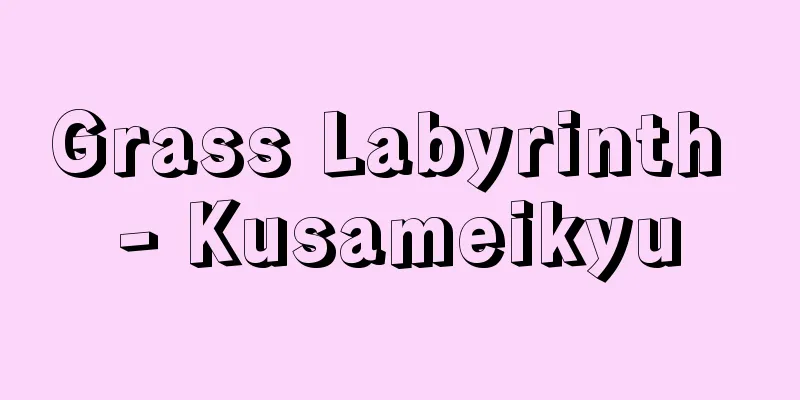Kagome Kagome

|
〘Noun〙 ("Kagome" may come from the imperative form of "kagomu", a variant of "kakomu (enclosure)") The name of a children's game. It is also a nursery rhyme sung at that time. A blindfolded person is squatted down by several other people singing around them, "Kagome kagome, when will the bird in the cage come out? At dawn, the crane and the turtle and the turtle are there, who is in front of me?" When the song is over, one of the people guesses the name of the person behind them, and the person who was guessed goes inside and squats blindfolded. There is also a version where two people face each other, take each other's hands, place one person inside, and sing the "Kagome kagome" song, and when they finish, they raise one hand high to pull the person out and allow the other person to take their place. A small Buddha inside. Kagome. [Tokyo Fuzokushi (1899-1902)] [Eloquence] (1) Examples of lines from songs can be found in “Kyoubun: Shiho no Aka (Red of the Four Directions), Vol. 1, Children’s Play Fushigi” (Crazy Writing), “The name ‘Tsurutsuru’ (smoothness) is appealing, so I sang ‘Kagome Kagome Kagome’” (Zappai: Tane Ooroshi-ichiroku) (‘The lid rest is a kagome kagome Chinese child’) and “Kagome kagome (Kagome Kagome) The bird in the cage, when will it come out? At dawn, smooth and smooth, it plopped down.” (2) Regarding the origin of the word "Kagome," in addition to the "enclosure" theory, there are other theories such as the "bending " theory, the "basket weave" theory, and the name of a bird. In addition, due to the unclear meaning of the lyrics and the variety of lyrics that have been passed down in different regions, it is speculated that the song underwent considerable changes before it became established as a game of addressing people asking, "Who is behind me?" (3) The most likely source of this is a kind of spirit-calling method in which a group of people surround one person, wait for the Jizo to take possession of that person, and then ask questions and listen to the answers. This is called "Jizo-asobi," "Jizo-mawashi," "Jizo-in-the-middle (small Buddha)," etc. Source: The Selected Edition of the Japanese Language Dictionary About the Selected Edition of the Japanese Language Dictionary Information |
|
〘名〙 (「かごめ」は「かこむ(囲)」の異形「かごむ」の命令形からか) 児童の遊戯の名。また、そのときに歌うわらべ歌。目隠しをしてしゃがんだ一人の回りを、他の数人が「かごめかごめ、籠の中の鳥は、いついつ出やる、夜あけの晩に、鶴と亀とつーぺった、うしろの正面だあれ」と歌いながら回り、歌い終わったとき、中の一人が背後の人の名をあて、あてられた者が次に中にはいって目隠しをしてしゃがむ。また、二人向かい合って両手を取り、中に一人入れて「かごめかごめ」の歌をうたって、終わると片方の手を高くあげて、中の者を出し、他の者が代わりにはいるようにするものもいう。中の中の小仏。かごめ。〔東京風俗志(1899‐1902)〕[語誌](1)「狂文・四方のあか‐上・児戯賦」に「つるつるといふ名にめでて、籠目籠目とうたふ」、「雑俳・種お卸‐一六」に「蓋置はかこめかこめの唐子にて」、「清元・月花茲友鳥(山姥)」に「かごめかごめかごの中の鳥はいついつ出やる夜明のばんにつるつるつるつっぱいた」など、歌の文句の例が見られる。 (2)「かごめ」の語源については、「囲め」説の他に、「屈(かが)め」説、「籠目」説、鳥の呼び名とみる説などがある。また、歌詞の意味の不明さや、各地に伝わる歌詞の多様さから、「うしろの正面だあれ」というあてもの遊びとして定着する以前に、かなりの変遷があったかと推測される。 (3)その源として有力視されるのは、一種の神寄せの方式で、一人を他の人々が囲み、その人に地蔵がのりうつるのを待って周囲の者が質問を出し、その答えを聞くというもの。「地蔵遊び」「地蔵まわし」「中の中の地蔵(小仏)」などと呼ばれる。 出典 精選版 日本国語大辞典精選版 日本国語大辞典について 情報 |
>>: Cacomistle - To surround (English spelling)
Recommend
Zermelo-Fraenkel set theory
…For these reasons, it was felt necessary to reco...
The Westminster Terms
…Simon became the leader of the reform movement. ...
Hebrews - Heburajin
Another name for the ancient Israelites. Derived ...
Kagen
This is an economics book written by Miura Baien ...
Water division - Bunsui
The former name of a town (Bunsui-machi) in Nishi...
ESR - ESR (English spelling) electron spin resonance
This is called electron spin resonance, also known...
Spinning industry
An industry that spins fibers into thread. The mai...
Kołobrzeg (English spelling)
A city in the Zachodnyo Pomorskie Voivodeship in n...
Sphenophyllum
An extinct genus of arthropod ferns in the order C...
Kokonchomonju - Kokonchomonju
A collection of tales from the Kamakura period. 2...
Didelphis marsupialis
…[Yoshiharu Imaizumi]. … *Some of the terminology...
Forgetting gratitude for nothing - Kionnyumui
〘Noun〙 To abandon feelings of love and affection, ...
Oboro Manju
...In the Kansai region, sweet potato manju is lo...
Complete linked system
…In contrast, when the names of two or more candi...
Rasūl Dynasty - Rasūl
An Islamic dynasty in Yemen (1230-1453). Rasul mea...









